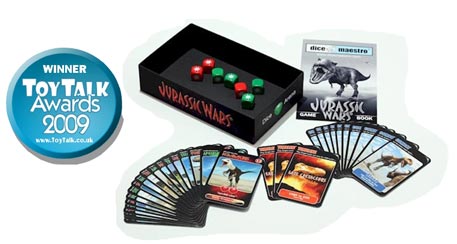Jurassic Wars – The Everything Dinosaur Interview
Jurassic Wars the dice based dinosaur combat game from those clever people at Dice Maestro has just won the prestigious Toy Talk product of the year, in the board and card games product category. Like all the products featured on the Everything Dinosaur website, this dinosaur themed game went through our testing programme. The comments and feedback from our testers and reviewers helps to decide what goes into our shop.
Jurassic Wars
As well as providing a fun, combat game involving lots of dinosaurs, (we really liked the computer generated pictures on the game cards), the game designers have tried hard to incorporate elements of the latest thinking about dinosaurs into the product. The is much to praise this Jurassic Wars dinosaur dice game.
The Award Winning Jurassic Wars Game

To view the wide range of dinosaur and prehistoric animal themed gifts available from Everything Dinosaur’s award-winning website: Visit Everything Dinosaur.
The Interview
We were asked to provide some feedback on Jurassic Wars and the interview is reproduced below.
1). Why do you think dinosaurs are so popular with children?
Dinosaurs seem to fascinate children and grown ups alike, there is nothing around like them today and as a group, dinosaurs thrived for over 150 million years. On average, a new dinosaur species is named and described every six weeks. Remote areas of the world are being explored for fossils, places such as Antarctica and the Australian outback, this exploration, coupled with the development of innovative technologies to study already prepared specimens, is helping scientists to learn so much more about these prehistoric animals.
2). Does Jurassic Wars help inform and educate young people about dinosaurs?
Jurassic Wars features twenty different dinosaurs, some of the most famous dinosaurs are included in the playing cards, animals such as the fearsome Tyrannosaurus rex, and Megalosaurus, the first dinosaur to be formerly named and scientifically described. However, Dice Maestro is keen to include representatives of less well known dinosaur genera, animals such as the bizarre Amargasaurus from South America. By playing the game, children can gain an understanding of the extraordinary diversity of the dinosaurs. It is also pleasing to see that a pronunciation guide is provided for every Dinocard, that attention to detail was noted by our product testers and is bound to be appreciated by mums and dads.
3). You Queried the Exact Duration of the Geological Time Periods Featured in Jurassic Wars – why is this important?
The Game Period cards on the timeline deck, feature two geological periods, these are divided into three chunks of time which are relevant to game play. Some leeway is given with regards to the start and ending of each geological period, due to the immense difficulties in correlating information relating to the accurate date of strata and the analysis of fossils they contain. However, most palaeontologists agree that the Jurassic period lasted from around 201 million years ago to approximately 144 million years ago, with the Cretaceous covering the time between 144 million years ago and the end of the Mesozoic Era approximately 66 million years ago
Defining geological time periods is the task of the International Commission on Stratigraphy; any changes proposed by this particular scientific body are then approved and ratified by the International Union of Geological Sciences, an international non-governmental organisation. Working to the same set of rules when it comes to defining geological time scales, helps scientists’ co-ordinate research and aids the consistency of reporting.
The geological time periods in Jurassic Wars encourage debate, allows questions to be asked and gives us the opportunity to explain the concept of geological time.
4). Some of the stunning computer generated dinosaur images show feathered dinosaurs, what is the significance of this?
A number of Dinocards in Jurassic Wars such as the cards representing Dromaeosaurus and Deinonychus show these animals covered in downy feathers. These illustrations reflect current scientific thinking that many smaller, active dinosaurs, especially theropods (a group of dinosaurs that includes the bipedal meat-eaters) were warm-blooded and covered with insulating feathers.
Several fossils of a sub-group of theropods, the Maniraptorans (the name means hand-snatchers) that includes the so-called “raptor dinosaurs” with the killer claws on the hind feet such as Deinonychus and Dromaeosaurus, indicate the presence of feathers. Scientists have put forward the theory that many more, small, meat-eating dinosaurs were feathered, but only a few fossils have been sufficiently well-preserved to leave any trace of feathers in the specimen. Feathered dinosaurs may have actually been quite common. Recent discoveries indicate that a number of small plant-eating dinosaurs may have also been feathered and feathered dinosaur fossils have been found in rocks dating back to the Middle Jurassic.
5). How do we know that dinosaurs fought each other?
We can observe animals fighting each other today, either different species fighting such as meat-eaters attacking plant-eaters (we call this interspecific combat) or animals of the same species competing for mates, or for social status in a herd (we call this intraspecific combat). Dinosaurs competed with each other, in the same way that animals alive today do. A close examination of fossilised bones can provide evidence of the injuries that dinosaurs suffered. For example, the lower left leg of the Tyrannosaurus rex skeleton on display at the Field Museum in Chicago, show signs of a break that subsequently healed.
It has been suggested that this injury was caused when this particular T. rex was bashed on the leg by the massive tail club of an Ankylosaurus. Both Tyrannosaurus rex and Ankylosaurus are featured in Jurassic Wars and there is some evidence in the fossil record to support the theory that these two, huge Late Cretaceous dinosaurs may have battled it out in a life or death struggle.






Leave A Comment